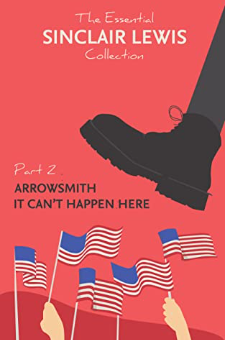 About The Essential Sinclair Lewis Collection: Arrowsmith & It Can’t Happen Here:
About The Essential Sinclair Lewis Collection: Arrowsmith & It Can’t Happen Here:
ALL of the BEST works of Nobel Prize in Literature winner Sinclair Lewis in one collection.
Not only Lewis’s most important book but one of the most important books ever produced in the United States” ~ New Yorker
“An eerily prescient foreshadowing of current affairs”~ The Guardian ”
A vain, outlandish, anti-immigrant, fear-mongering demagogue runs for President of the United States – and wins. Sinclair Lewis’s chilling 1935 bestseller It Can’t Happen Here is the story of Buzz Windrip, ‘Professional Common Man’, who promises poor, angry voters that he will make America proud and prosperous once more, but takes the country down a far darker path. As the new regime slides into authoritarianism, newspaper editor Doremus Jessup can’t believe it will last – but is he right?
This cautionary tale of liberal complacency in the face of populist tyranny shows it really can happen here.A 1935 dystopian political novel by American author Sinclair Lewis.
It Can’t Happen Here describes the rise of a US dictator similar to how Adolf Hitler gained power.
“Every man is a king so long as he has someone to look down on.”~ Sinclair Lewis, It Can’t Happen Here
This updated version Includes:
– a biography of Sinclair Lewis
– Commentary on Arrowsmith and It Can’t Happen Here included
Arrowsmith, Sinclair Lewis’ critically acclaimed book, reigns as one of the supreme achievements of Sinclair Lewis’ writing career. First published in 1925. This quintessential science novel has been loved by generations of readers. It’s the type of book you want to read over and over again!
Experience the wit and wisdom of this bestselling classic novel – the critically acclaimed novel that won the 1926 Pulitzer Prize for Fiction (which Sinclair famously declined).
“He saw no one clear path to Truth but a thousand paths to a thousand truths far-off and doubtful.” ~ Sinclair Lewis, Arrowsmith
Arrowsmith examines medicine in the modern world through the eyes of an idealistic man. A young physician and researcher who dedicates himself to the pursuit of scientific truth even in the face of personal tragedy, corruption, and greed.
Often described as the first “scientific” novel, Arrowsmith explores medical and scientific themes in a fictional way and it is difficult to think of an earlier book that does this. Although he was not a doctor, Sinclair Lewis’s father was and he was greatly helped in the preparation of the manuscript by the science writer Paul de Kruif. It was de Kruif who brings a reality to the book that is almost biographical.
Widely considered by audiences and literary critics to be The Great American Novel.
As relevant today as it was almost 100 years ago!
Buy the book:
Author Bio:
Harry Sinclair Lewis was born on February 7, 1885, in Sauk Centre, Minnesota, to Edwin J. Lewis and Emma Kermott Lewis.
His grandfather, father, and older brother were all doctors in tiny towns. Lewis was a shy, lonely adolescent who enjoyed reading. He began writing in high school, and some of his works were published in local newspapers in Sauk Centre.
Lewis left Minnesota after high school to attend Yale University in Connecticut, pausing his studies in 1907 to work at Helicon Hall, a New Jersey socialist colony founded by the writer Upton Sinclair (1878–1968). Lewis spent several years after graduating in 1908 working as a newspaper and editorial writer in various locations of the United States.
His first four books were all failures. With the publication of Main Street in 1920, Lewis gained instant worldwide notoriety as the narrative of a gifted young lady married to a dull, much older village doctor who seeks to bring culture and imagination to a barren, small-town life.
Next, in Babbitt (1922), possibly his most famous piece, Lewis concentrated on an American businessman. Lewis wrote in a fantastical style on purpose, ignoring story development and organization.
Lewis’s most outstanding achievement is the creation of George F. Babbitt, an intellectually worthless, immature man with poor morals who is yet a delightful comedy figure. “If Babbitt could write, he’d write like Sinclair Lewis,” one critic said.
Belated novels and the Nobel Prize Arrowsmith (1925), Lewis’s next popular work, reverted to the form of Main Street to depict a young doctor’s struggle to maintain his dignity in a petty, dishonest environment.
Arrowsmith was awarded the Pulitzer Prize despite its frequently naive view of science as a way of salvation. Lewis, on the other hand, promptly declined the accolade because the award’s criteria stipulated that it be granted not for valuable work, but for one that depicts “the wholesome atmosphere of American Life.”
.
For more classic books please visit www.thevinedresser.com/classicbooks